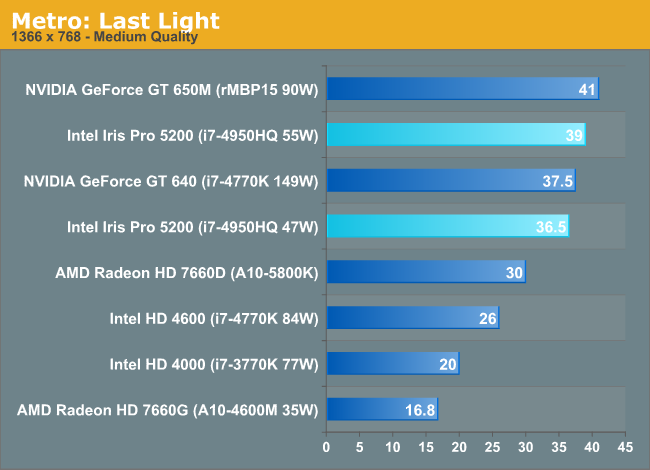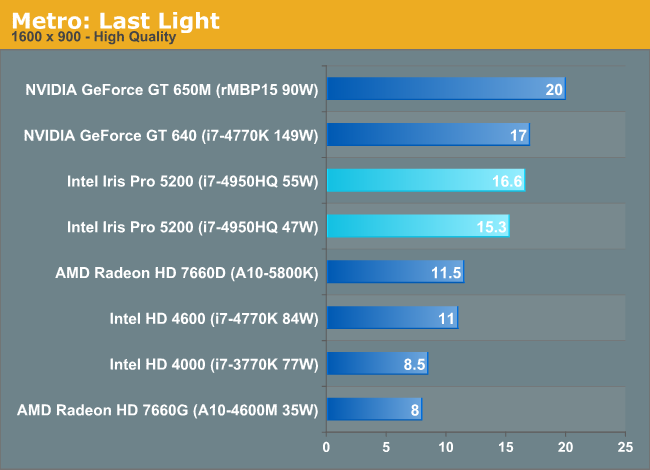Intel Iris Pro 5200 Graphics Review: Core i7-4950HQ Tested
by Anand Lal Shimpi on June 1, 2013 10:01 AM ESTMetro: Last Light
Metro: Last Light is the latest entry in the Metro series of post-apocalyptic shooters by developer 4A Games. Like its processor, Last Light is a game that sets a high bar for visual quality, and at its highest settings an equally high bar for system requirements thanks to its advanced lighting system. This doesn’t preclude it from running on iGPUs thanks to the fact that it scales down rather well, but it does mean that we have to run at fairly low resolutions to get a playable framerate.

Metro is a pretty heavy game to begin with, but Iris Pro starts off with an extremely good showing here. In its 55W configuration, Iris Pro is only 5% slower than the GeForce GT 650M. At 47W the gap is larger at 11% however. At 1366 x 768 the difference seems less memory bandwidth related and has more to do with efficiency of the graphics hardware itself.
The comparison to mobile Trinity is a walk in the park for Iris Pro. Even a 100W desktop Trinity part is appreciably slower here.

Increasing the resolution and quality settings changes things quite a bit. The 650M pulls ahead, and now the Iris Pro 5200 basically equals the performance of the GT 640. Intel claims a very high hit rate on the L4 cache, however it could be that 50GB/s is just not enough bandwidth between the GPU and Crystalwell. The performance improvement compared to all other processor graphics solutions, regardless of TDP, is still well in favor of Iris Pro. The i7-4950HQ holds a 50% advantage over the desktop i7-4770K and is almost 2x the speed of the i7-3770K.
Comparing mobile to mobile, Iris Pro delivers over 2x the frame rate of Trinity.










177 Comments
View All Comments
whyso - Saturday, June 1, 2013 - link
They are completely different systems making power consumption values irrelevant.codedivine - Saturday, June 1, 2013 - link
Hi folks. Can you post the OpenCL extensions supported? You can use something like "GPU Caps viewer" from Geeks3d.tipoo - Saturday, June 1, 2013 - link
Interesting that the compute is punches above it's game performance weight. I wonder if they could put more EUs in a chip, maybe a larger eDRAM, and put it on a board as a compute card.lmcd - Saturday, June 1, 2013 - link
They already have a compute card called Xeon Phi if I remember correctly.Klimax - Sunday, June 2, 2013 - link
Different Arch (X86 in Phi)tipoo - Sunday, June 2, 2013 - link
I'm aware, but the Xeon Phi requires completely different programming than a GPU like this which can just use OpenCL.Soul_Master - Saturday, June 1, 2013 - link
What's your point for comparing desktop GPU with middle-range mobile GPU? CPU on both devices are not equal.Soul_Master - Saturday, June 1, 2013 - link
Sorry. I misunderstood about i7 4950HQ process, a high-end quad-core processor for laptops.Ryan Smith - Sunday, June 2, 2013 - link
It's what we had available. We wanted to test a DDR3 version of GK107, and that's what was on-hand.tipoo - Saturday, June 1, 2013 - link
Hmm, so it's heavily hinted at that the next rMBP will ditch discreet graphics. The 5200 is good, but that would still be a regression in performance. Not the first time Apple would have done that, there was the Radeon cut out of the Mini, the 320M to the 3000, even the bottom rung of the newest iMac with the 640m. I wonder if it would at least be cheaper to make up for it.